Archer Aviation Set to Revolutionise Los Angeles Transport with Air Taxis by 2026
The FAA has approved Archer Aviation to launch an aerial car rental service in New York City ahead of the 2028 Olympics
 Cheng Yuan
Cheng Yuan
Author: Delphi Digital; Compiler: 0xxz@金财经
In 2024, the on-chain economy will grow significantly, with daily The transaction volume increased by more than 50%, the total value locked (TVL) on the chain increased by 70%, and the total TVL of the major networks exceeded 70 billion US dollars. These major networks include Bitcoin, Ethereum, Solana, Arbitrum, Avax, Base, Binance Smart Chain, Cosmos, Optimism, Polygon, Sei, and Sui. The World Economic Forum predicts that 10% of global GDP will be on-chain by 2027, a prediction further confirmed by reports from the International Monetary Fund and the World Bank on the global shift to digital infrastructure.
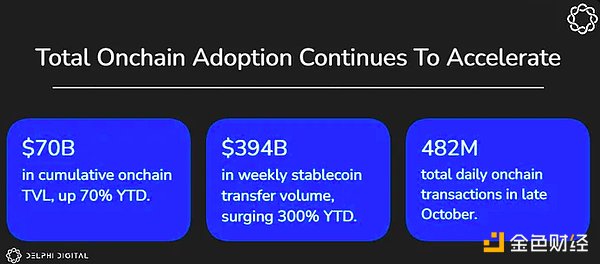
This report provides in-depth research It examines the recent growth of the on-chain economy through October 2024 and analyzes several use cases behind this growth, including stablecoins, L2, collectibles, social media, gaming, DeFi, and institutional adoption. Overall, the data is clear: the on-chain economy is growing rapidly.
This report also provides an in-depth look at Base’s recent developments. Base, an Ethereum L2 incubated by Coinbase, has experienced significant growth since launching its mainnet on August 9, 2023.
“Base is a secure, low-cost, developer-friendly Ethereum L2 designed to serve one billion users and one million chains ”
In the approximately one year since Base was launched, it has positioned itself at the forefront of the L2 field. During this time, the Base team has contributed to progress on multiple chains: reducing rollup transaction fees to less than 10 cents via EIP-4844, creating smart wallets to simplify account abstraction, contributing to the hyperchain stack, and more. Daily transaction volume on Base has grown 1,600% since early January, from 372,000 to more than 6.63 million in October. Of the many metrics analyzed, Base is growing faster relative to the overall on-chain economy (such as TVL, active addresses, and transactions).
The growth of the on-chain economy is not limited to financial speculation. 66% of all active on-chain applications are non-DeFi, such as gaming, social, and digital collectibles. DeFi applications account for 33% of on-chain applications on major networks.
As new use cases continue to emerge and developers and users continue to get on-chain, the on-chain economy will accelerate in the coming months and years.
On-chain indicators
On-chain Total TVL
Total Value Locked (TVL) is a metric used to evaluate the amount of capital allocated to smart contracts on a specific network. Year-to-date, cumulative TVL across networks has grown from $41 billion to more than $70 billion, a 70% increase. TVL grew 110% to $87.9 billion as of November 19.
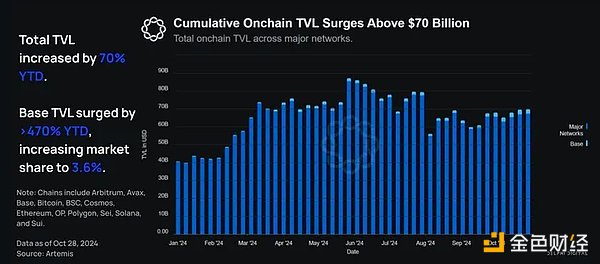 As the total TVL on the chain surges, Base grows Especially prominent. TVL on the Base chain increased from $439 million in January 2024 to $2.51 billion at the end of October 2024, an increase of 470%. As a result, Base’s market share increased from 1.07% of total on-chain TVL to 3.59%.
As the total TVL on the chain surges, Base grows Especially prominent. TVL on the Base chain increased from $439 million in January 2024 to $2.51 billion at the end of October 2024, an increase of 470%. As a result, Base’s market share increased from 1.07% of total on-chain TVL to 3.59%.
It is worth noting that although on-chain growth is driven by Base, this is mainly reflected in active addresses and stablecoin transaction volume. This is because on-chain TVL on Base is still relatively low compared to other major networks - reflecting the greater mix of non-monetary use cases on Base.
This significant rise stems from increased usage of Base in general and, more specifically, the rising popularity of Aerodrome, which currently accounts for over 40% of Base TVL.
Total active addresses on-chain
Year-to-date, the total number of weekly active addresses on-chain has increased from 19.3 million to approximately 60 million, a 210% increase. Weekly active addresses grew 240% to 65.6 million as of November 19.
Note: As a reminder, the active address refers to the active interaction address of the project's revenue-generating smart contract within a given time period. Active addresses are not equivalent to weekly active users, as users may create and operate multiple wallet addresses.
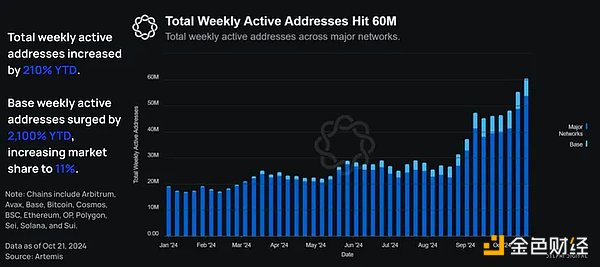 At the same time, Base’s weekly active address count It increased from 300,000 in January to 6.61 million at the end of October, an increase of 2,100%. This increases Base's market share of the total weekly active addresses on-chain from1.6% to 11%
At the same time, Base’s weekly active address count It increased from 300,000 in January to 6.61 million at the end of October, an increase of 2,100%. This increases Base's market share of the total weekly active addresses on-chain from1.6% to 11%
Note: Daily new addresses refer to newly created interactive addresses within the 24 rolling cycle, which interact with smart contracts that generate revenue. These addresses have not previously indicated any on-chain activity on the network.
So far this year, the total number of new daily active addresses has increased from 710,000 to 6.95 million, an increase of 879%.
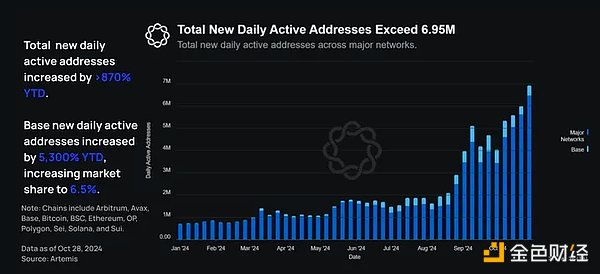 During the same period, Base's daily new additions Active addresses increased from 8,320 at the beginning of the year to 450,000 at the end of October, an increase of 5,300%. This increased Base's market share from 1.2% to 6.5%.
During the same period, Base's daily new additions Active addresses increased from 8,320 at the beginning of the year to 450,000 at the end of October, an increase of 5,300%. This increased Base's market share from 1.2% to 6.5%.
Total number of on-chain transactions
The number of transactions is quantified by evaluating the number of transactions conducted within a given time frame.
So far this year, the cumulative number of weekly transactions has increased from 315 million at the beginning of the year to 482 million, an increase of more than 50%. As of November 19, the number of weekly on-chain transactions so far this year has increased by more than 60% to 531 million.
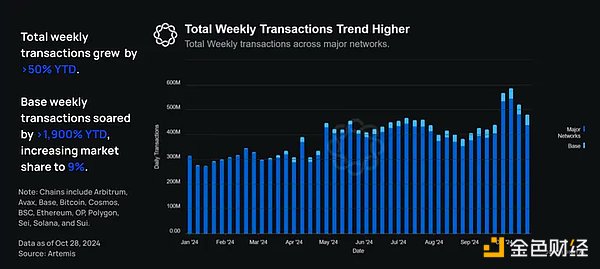 During the same period, Base’s daily trading volume ranged from The number of transactions at the beginning of the year increased from 2.1 million to 42.34 million at the end of October, an increase of more than 1,900%. This increased Base's market share from 0.67% to 9%.
During the same period, Base’s daily trading volume ranged from The number of transactions at the beginning of the year increased from 2.1 million to 42.34 million at the end of October, an increase of more than 1,900%. This increased Base's market share from 0.67% to 9%.
Base's huge increase in daily transaction volume shows that the network's popularity and affordability are rising, but the broader trend also highlights that Base can succeed while enabling other networks to succeed ( For example, other networks in the hyperchain).
Total amount of deduplicated stablecoins
A key area of economic growth on the chain is stablecoins, which enable on-chain assets to be traded at traditional financial costs. A small portion moves seamlessly around the world. Year-to-date, total deduplicated on-chain stablecoin weekly trading volume has increased from $89.7 billion to $249 billion, an increase of more than 177%.
As of November 11, weekly stablecoin transfer volume was 302 billion, a year-to-date increase of more than 235%.
Note: Deduplicated stablecoin trading volume is quantified by evaluating the cumulative sum of stablecoin transfer values while removing duplicates. Removing duplicates is critical to analyzing accurate volume numbers. Duplicates are transfers that are considered uneconomic activities, such as CEX transfers, bot activity, fake transactions, and non-payment wallet transfers.
 Base The growth of stablecoins is also accelerating rapidly: During the same time period, Base's cumulative weekly stablecoin trading volume increased from $620 million in early January to $62 billion at the end of October, an increase of more than 9,800%. This increased Base's market share from0.7%to33% a growth of47 times.
Base The growth of stablecoins is also accelerating rapidly: During the same time period, Base's cumulative weekly stablecoin trading volume increased from $620 million in early January to $62 billion at the end of October, an increase of more than 9,800%. This increased Base's market share from0.7%to33% a growth of47 times.
As of November 11, Base’s cumulative weekly stablecoin trading volume increased from $620 million in early January to $55 billion in November, an increase of more than 8,800%. This increased Base's market share from 0.7% to 18%.
The increase in Base stablecoin transaction volume reflects Base’s efforts to reduce costs while increasing network capacity. As a result, Base can leverage stablecoins as a universal medium of exchange to process large-scale payments between consumers and merchants.
Institutional Adoption
Institutional adoption of on-chain public permissionless networks is critical to the long-term success of the broader crypto ecosystem and is currently in its early stages stage. The Bitcoin and Ethereum spot ETFs were approved in January and June 2024, respectively, but have already seen massive adoption—with total net flows exceeding$24 billion. While we expect the ETF trend to grow significantly from here on out, this is just Web2 wrapping Web3 products. Tokenization, which can be thought of as the native transfer of traditional web2 assets onto the chain, is the future of institutions and is receiving significant attention from governments and the private sector around the world. To access all of web3, organizations need a scalable, secure, and appropriately licensed marketplace infrastructure.
Real World Assets (RWA) are digital tokens that represent physical assets or financial instruments on the blockchain. This includes real estate, art, merchandise, etc. Tokenizing RWA on-chain allows for fractional ownership and opens up new possibilities for trading, investing, and ownership. The growth of RWA is a key driver of on-chain economic growth.
A number of different metrics can be evaluated to determine growth in institutional adoption. Currently, the best metric is total RWA growth, as it describes the actual capital on the chain.
The total RWA value of the entire network (excluding private credit and stablecoins) is $3.92 billion, of which tokenized treasury bonds account for 62%.
The total value of risk-weighted assets is up more than 50% so far this year, from $8.3 billion to $13.25 billion.
Ethereum has received over $3 billion in RWA.
Data from RWA.xyz shows that RWA is achieving considerable growth and will continue to grow as more institutions join the chain.
Tokenized value growth broken down by category
With the successful approval of a Bitcoin spot ETF, institutional focus has turned to the tokenization of RWA .
A quote from BlackRock CEO and founder Larry Fink sums up institutional sentiment well:
“ETFs < /em>is the first step in the technological revolution of financial markets, the second step is the tokenization of all financial assets”
There is a huge push to tokenize financial assets so that they can benefit from an unrestricted on-chain economy. As seen by major traditional financial institutions such as BlackRock and Franklin Templeton, they have begun issuing RWA on-chain.
Currently, tokenized treasury bonds account for the majority of issued RWA, with commodities ranking second:

The growth in tokenized treasury bonds occurred primarily on Ethereum L1, exceeding $1.5 billion. Only $4.5 million in tokenized Treasuries have been issued on Base, but the space is already primed for growth. As the network matures and decentralizes further by achieving the next stage, which is the level of decentralization, Base will be ready for the influx of on-chain assets.
On-chain developers are an important part of the on-chain ecosystem - an active developer ecosystem promotes innovative applications The creation of programs that attract users to a network and retain them.
Generally, the number of full-time developers on each chain is considered the most important metric for measuring developer activity. As of the latest developer report on June 24, Base ranks second with more than 900 active full-time developers, behind Ethereum (about 2,800).
Note: A full-time developer is defined as a developer who commits code for more than 10 days per month.
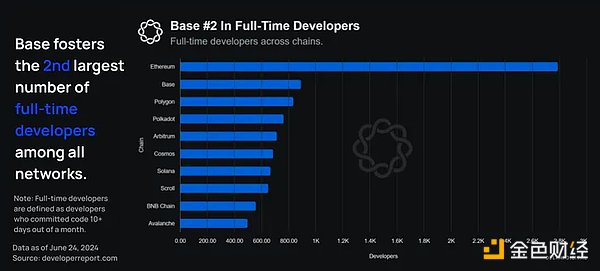
NFT trading volume is quantified by calculating the sum of NFT trading volumes within a given time frame. Cumulative weekly NFT trading volume has dropped from 309 million to 59 million so far this year, a drop of approximately 80%.
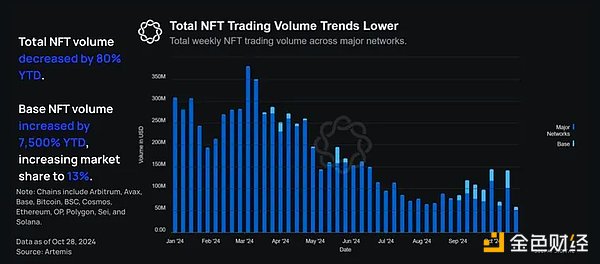 During the same time period, Base accumulated NFT transaction volume It increased from about 100,000 in early January to 7.66 million, an increase of more than 7,500%. This increased Base's market share from 0.003% to 13%. NFT growth on Base has been driven primarily by the promotion of free or low-cost NFTs rather than speculative NFT trading activity, indicating a shift in NFT market focus in recent years.
During the same time period, Base accumulated NFT transaction volume It increased from about 100,000 in early January to 7.66 million, an increase of more than 7,500%. This increased Base's market share from 0.003% to 13%. NFT growth on Base has been driven primarily by the promotion of free or low-cost NFTs rather than speculative NFT trading activity, indicating a shift in NFT market focus in recent years.
While NFT trading volume on major networks has been trending downward due to market conditions and many high-profile NFT values falling by approximately 80%, NFT trading volume on Base has increased significantly. This is largely because Base NFTs were virtually non-existent at the beginning of the year, and now their trading volumes are more in line with the overall market for NFTs.
In general, while the entire on-chain field continues to grow, Base has also achieved accelerated growth. What's more, Base's market share across all analyzed metrics has grown several times year-to-date, demonstrating Base's clear relative strength and outperformance in terms of economic growth and user adoption.
For example:
Since early January, the number of daily transactions has increased by 1,600%, from 372,000 to more than 6.63 million transactions in October.
Daily transaction volume has increased by more than 50% so far this year.
Weekly active addresses have increased by over 2100% year to date.
YTD total value locked is up over 70%.
This also proves the efforts of Base and other development teams to build beneficial applications and networks and promote economic growth on the entire chain.
While Base is growing faster than other networks in all of the following metrics, it's worth noting that usage is up on most major networks so far this year, suggesting that bringing people to The joint effort to get on-chain is benefiting all networks.
Data from January 2024 to October 2024 tells a unique story:Base adoption Rates are soaring.
Weekly active addresses and transaction volume on Base have increased steadily, increasing by more than 2,100% and 1,600% respectively from January to October 2024. The impressive progress shows that Base is effectively attracting users and expanding on-chain adoption globally.
It should be noted that weekly active addresses are not equivalent to weekly active users, because users may create and operate multiple wallet addresses, which means the correspondence is not 1:1. Nonetheless, it is still a useful metric for assessing overall activity levels on the chain, especially when filtering for addresses that interact with revenue-generating smart contracts, as is done in this report.
In 2024, weekly active addresses on Base surged from 300,000 in January to 6.61 million at the end of October, reaching an all-time high of 7.19 million on September 16. The increase represents a year-to-date increase of more than 2,100%.
Note: Base Weekly active addresses refer to the number of unique addresses that have interacted with revenue-generating smart contracts deployed on Base . A person may be active at multiple addresses.
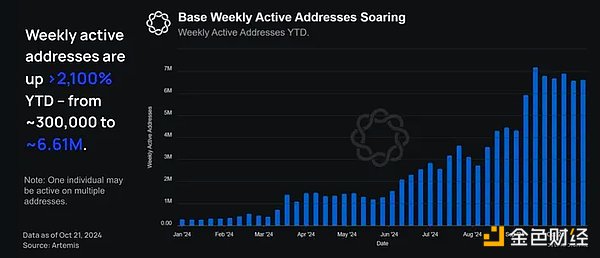
As of November 19 On Sunday, Base's weekly active addresses increased by 2,000% to more than 6.5 million.
These initiatives have successfully fostered a growing ecosystem. Coupled with the significant reduction in transaction fees after EIP-4844 (typical fees are now less than 1 cent), Base has become a very attractive chain to work with from both a user and developer perspective interactive.
So far this year, Base's daily new addresses have grown from 9,300 in January to 670,000 at the end of October, hitting an all-time high of 867,700 on September 20. The increase marks more than 7,100% growth since the start of the year.
Note: The daily new addresses of Base refer to the number of new addresses that interact with the revenue-generating smart contracts deployed on Base for the first time (does not mean < em> Base any previous on-chain activity).
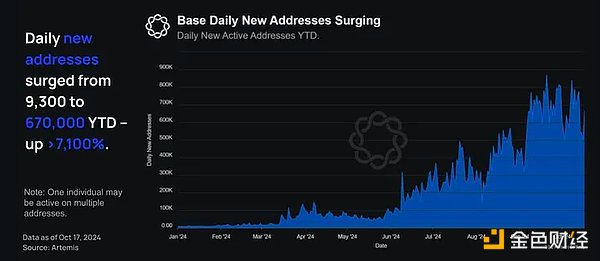 At the same time, Base's daily return address is from January's 59,000 increased to more than 1 million in October, peaking at 1.23 million on October 3. This equates to a year-to-date increase of over 1,600%, a strong indication that user retention remains strong despite the surge in activity.
At the same time, Base's daily return address is from January's 59,000 increased to more than 1 million in October, peaking at 1.23 million on October 3. This equates to a year-to-date increase of over 1,600%, a strong indication that user retention remains strong despite the surge in activity.
Note: Base daily return address refers to the number of interactive addresses that have previously interacted with revenue-generating smart contracts deployed on Base .
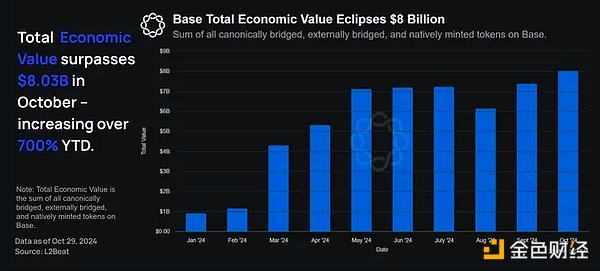 An example of promoting activities on the Base chain is Onchain Summer program, which celebrates and showcases on-chain innovation - including music, art, food and games. The program encourages participation by showcasing compelling on-chain projects in the Base ecosystem. This effort has helped bring users on-chain, as evidenced by the surge in on-chain activity.
An example of promoting activities on the Base chain is Onchain Summer program, which celebrates and showcases on-chain innovation - including music, art, food and games. The program encourages participation by showcasing compelling on-chain projects in the Base ecosystem. This effort has helped bring users on-chain, as evidenced by the surge in on-chain activity.
Another factor supporting Base’s success is the diverse marketing campaigns that reach a wide target audience, such as advertising on Liquid Death boxes to promote on-chain activity.
Separately, Coinbase launched cbBTC, a wrapped Bitcoin token, on Base. By prioritizing cbBTC adoption on Base, they help solidify Base’s position as the leading ecosystem for the most secure on-chain wrapped Bitcoin.
Programs like cbBTC and Onchain Summer help bring the masses on-chain. Once they're here, they're here to stay, as the active addresses returned indicate.
Not surprisingly, with the increase in active addresses, daily on-chain transaction volume has also surged.
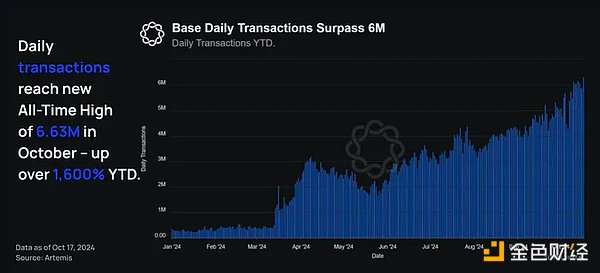 As of 11 On 19 , the number of daily transactions increased by 1,900% to more than 770 .
As of 11 On 19 , the number of daily transactions increased by 1,900% to more than 770 .
In particular, the number of daily transactions has increased by 1,600% since the beginning of January, from 372,000 to more than 6.63 million in October. Both active addresses and transaction volume show similar trends, which proves that the Base economy is becoming an on-chain hub in the Rollup field.
In contrast to web2 dynamics, the cost of doing business on Base has fallen despite soaring demand. Average transaction fees on Base fell from $0.44 in the first quarter to $0.019 on October 17, a dropof more than 95% . While this is partly due to EIP-4844, the scaling work Base has been doing (such as increasing the gas limit) has played a significant role in reducing costs.
Specifically, average transaction fees have drop by more than 95% so far this year, while However, the average daily transaction volume surged 800% from 615,000 transactions in the first quarter to 5.6 million transactions in October. These low fees make on-chain technology more popular and encourage more developers and users to join the chain.
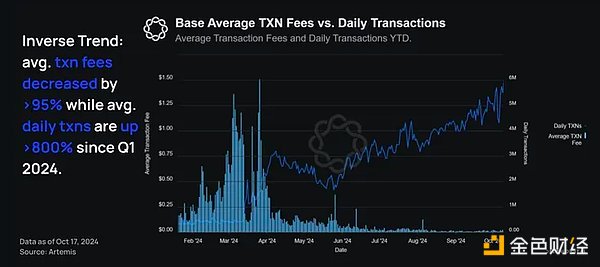
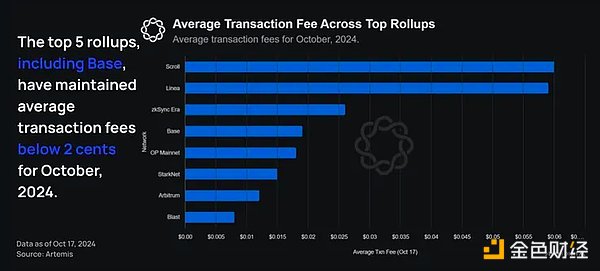 On the other hand, Base is currently the largest gas consumer among rollups using blobs, lasting every second Processing >50 transactions, consuming >13 mgas/s.
On the other hand, Base is currently the largest gas consumer among rollups using blobs, lasting every second Processing >50 transactions, consuming >13 mgas/s.
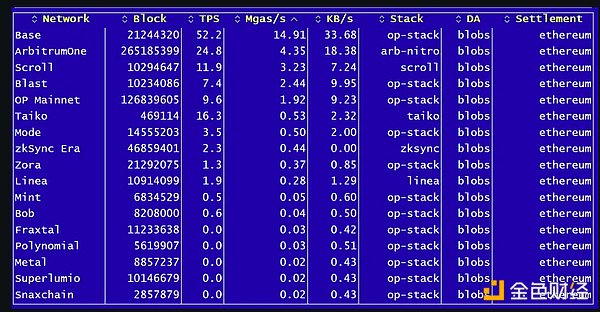
Base submitted all More than 29% of the blob, indicating the huge demand for Base block space, which is the result of the explosive growth of the Base chain.
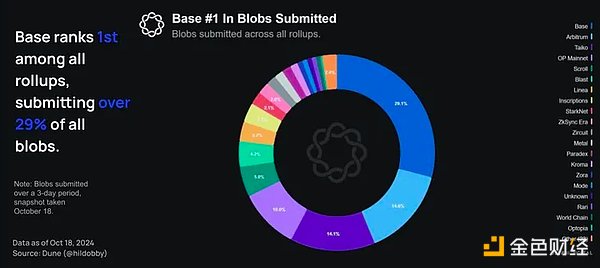 However, this may cause problems in the future. If the maximum number of blobs is not increased in future upgrades, the current cap may hinder Base growth.
However, this may cause problems in the future. If the maximum number of blobs is not increased in future upgrades, the current cap may hinder Base growth.
YTD growth in underlying economic value and total locked value
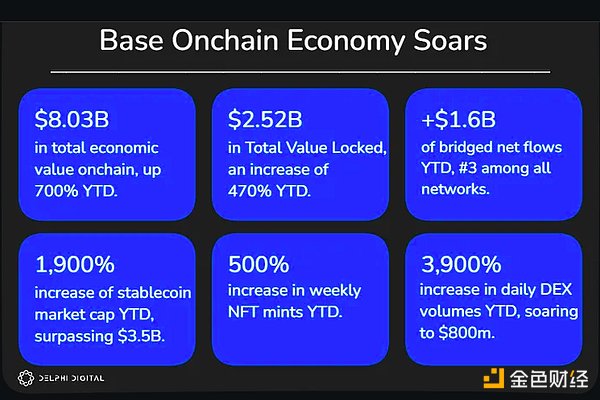 So far this year, Base's total economic value has risen from US$900 million in January to US$8.03 billion at the end of October, an increase of 792%. This number makes Base the second largest L2 in this metric, behind Arbitrum.
So far this year, Base's total economic value has risen from US$900 million in January to US$8.03 billion at the end of October, an increase of 792%. This number makes Base the second largest L2 in this metric, behind Arbitrum.
Note: Total economic value refers to the sum of all canonical bridges, external bridges, and locally minted tokens
 Remarkably, this growth is unparalleled and the fastest ever for a network to accumulate more than $8 billion in total economic value (in just one 16 months!). We expect this economic value chart to maintain its trend as heavy inflows are expected to continue over the next few years.
Remarkably, this growth is unparalleled and the fastest ever for a network to accumulate more than $8 billion in total economic value (in just one 16 months!). We expect this economic value chart to maintain its trend as heavy inflows are expected to continue over the next few years.
Additionally, Base ranks third in terms of net traffic (nominal traffic, not %), with $1.6 billion in net traffic across all networks so far this year, compared to Ethereum’s net outflows of 65 billion dollars. It must be admitted that most of the outflows experienced by Ethereum are mainly the migration of capital into rollups, indicating that capital flows mainly stay within the EVM ecosystem rather than moving out of the ecosystem.
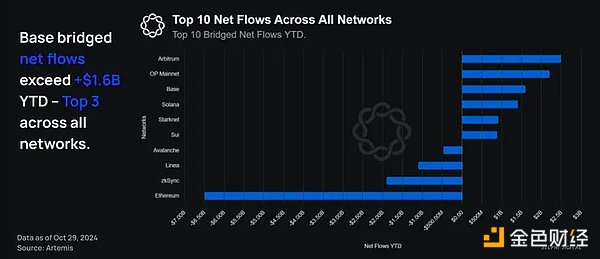 So far this year, the TVL of the Base protocol has changed from It rose from US$439 million in January to US$2.52 billion at the end of October, an increase of 470%. As of November 8, Base’s TVL has exceeded $2.77 billion, making it the leading L2 by total value locked.
So far this year, the TVL of the Base protocol has changed from It rose from US$439 million in January to US$2.52 billion at the end of October, an increase of 470%. As of November 8, Base’s TVL has exceeded $2.77 billion, making it the leading L2 by total value locked.
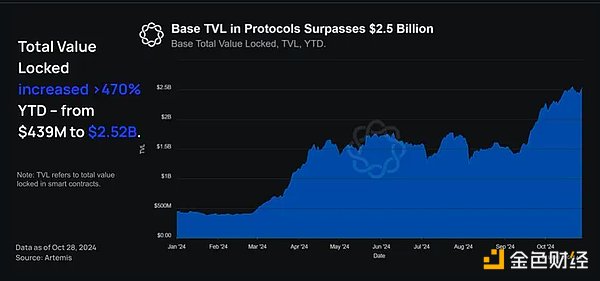 The ratio to be monitored is TVL/total economic value, Because a healthy ecosystem will allow both metrics to grow at a similar rate.
The ratio to be monitored is TVL/total economic value, Because a healthy ecosystem will allow both metrics to grow at a similar rate.
By directly comparing each metric, we can gain a deeper understanding of the overall distribution of activity on the chain. The similarity between TVL and total economic value shows that most capital is locked in protocols and smart contracts, indicating active DeFi activity. On the other hand, if the total economic value significantly exceeds TVL, it would indicate on-chain activity beyond the scope of DeFi, highlighting a more diverse distribution — which is the case with Base.
Based on all of the above metrics and many others, Base is the fastest growing L2.
Another interesting way to quantify the "success" of a network is to track the overall market cap of stablecoins on the network.
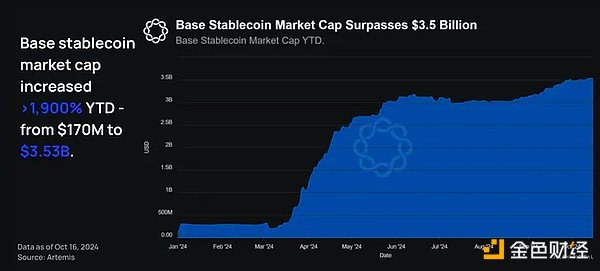 So far this year, the market value of stablecoins on Base has It rose from $170 million in January to $3.53 billion at the end of October, an increase of more than 1,900%. This represents a significant increase in both nominal value and percentage.
So far this year, the market value of stablecoins on Base has It rose from $170 million in January to $3.53 billion at the end of October, an increase of more than 1,900%. This represents a significant increase in both nominal value and percentage.
As of November 19, the market value of stablecoins on Base was US$3.3 billion (an increase of more than 1800% from US$170 million in January), while the market value of all network stablecoins was US$186 billion ( (up 38% from $134 billion in January).
It is worth noting that this percentage increase exceeds the increase in economic value during the same period, indicating that the Base ecosystem is not only growing, but also beginning to mature.
Multiple use cases beyond DeFi
With the With the rapid growth of users and transaction volume, the number of projects launched on Base is also increasing steadily. A thriving ecosystem is a sign of a healthy network, and it's clearly driven by Base's commitment to delivering an unparalleled developer experience. As of October 17, 2024, there are 85 active applications on Base and more than 100 daily active wallets.
More than 60% of on-chain applications on Base have nothing to do with DeFi: gaming applications account for 20%, collectibles account for 18.8%, social applications account for 15.3%, and "other" accounts for 5.9%.
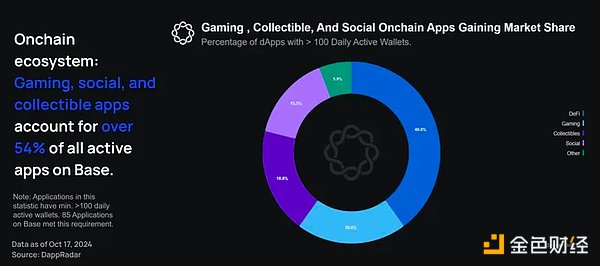
As shown above, While DeFi applications lead as a single category, areas such as games and collectibles also see high usage, accounting for more than 54% of all active applications on Base.
The diversity of applications on the chain shows that Base is more than just a DeFi hub. It is a space where all types of on-chain applications can flourish and form a real economy. This is further supported by the growth of apps like FrenPet, which focus on gameplay rather than monetary gain.
The diversity of applications on Base is roughly similar to the cumulative application diversity of the major networks supported by DappRadar.
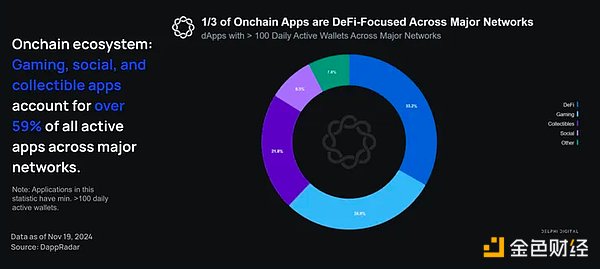 These practical functions provided by dApp show that users are beginning to accept all Types of on-chain applications. This is a healthy sign for the on-chain ecosystem, which is growing in diversity beyond currency-centric applications.
These practical functions provided by dApp show that users are beginning to accept all Types of on-chain applications. This is a healthy sign for the on-chain ecosystem, which is growing in diversity beyond currency-centric applications.
Dividing the year into two periods after and before EIP-4844, the average transaction fee for users increased from EIP -4844 followed by $0.422 fell 70% to $0.097.
As mentioned earlier, after the implementation of EIP-4844, transaction fees on Base dropped by 70%, which promoted the rapid growth of transaction volume. Continued improvements in cost efficiency will unlock significant expansion of on-chain use cases and help attract new users to the chain.
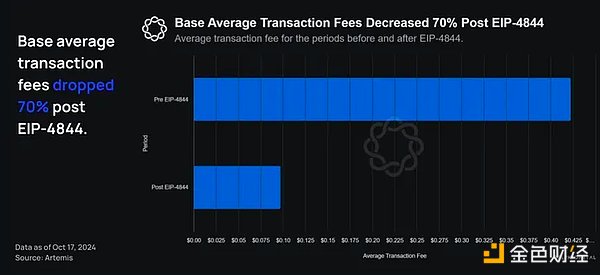 With the reduction of transaction costs, on-chain applications are completely Eliminating gas fees becomes more feasible. With the payer bearing minimal transaction fees, users do not need to consider paying gas fees with ETH.
With the reduction of transaction costs, on-chain applications are completely Eliminating gas fees becomes more feasible. With the payer bearing minimal transaction fees, users do not need to consider paying gas fees with ETH.
Base is not the only L2 where users are seeing fee reductions, however. Development work made by Base outside of its own rollup (especially EIP-4844) benefits all rollups. The biggest advantage of cheap transactions is that on-chain applications can provide gas fees through paymaster. By paying transaction fees themselves through the application (the lowest cost per transaction), users don’t need to think about paying gas fees in ETH.
This simplifies the entry barrier for new users. If full abstraction does become possible in the future - where the on-chain user experience is very similar to web2, by being streamlined to the point where users don't know they are interacting with the blockchain - then applications will be able to absorb the gas fee costs without compromising on Significant impact on profitability.
As Base fees continue to drop and approach the cheapest, economically feasible cost, the possibilities for on-chain exploration are nearly endless.
Coinbase Smart Wallet will launch in June 2024 Launched in March, it is an advanced wallet designed to optimize user experience and simplify the onboarding process. There are no extensions/installations required, passwords are used instead of complex mnemonics, and the wallet works on most major networks. Smart wallets shorten the user on-chain process to just a few seconds and clicks.
After hitting an all-time high of 21,660 in August, the number of Coinbase Smart Wallet monthly active wallets has surged 168% since launch in June - from 5,700 to 15,280.
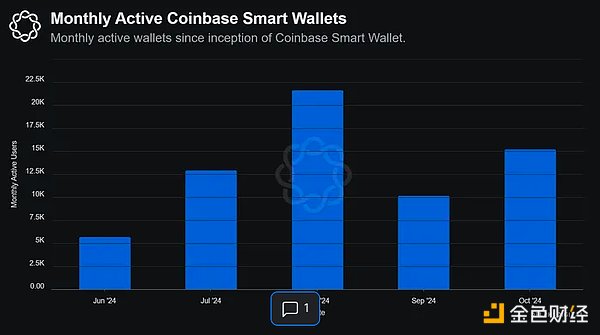
Also, use Coinbase The number of monthly wallet operations for smart wallets surged 125% from 31,200 to 70,320, reaching an all-time high in October 2024.
Note: Data refers to on-chain interactions using the Coinbase smart wallet.

There are four main factors in creating a developer-friendly environment on Base:
Base is built as a standardized EVM, which means developers can write applications using Solidity, the most popular blockchain programming language.
Base is part of Superchain, a rollup network using OP Stack, allowing Base to share security and communication layers with other rollups. As a result, Base is more attractive to developers due to increased interoperability between Superchain rollups and the support it receives from other Superchain developers.
The Coinbase Developer Platform and Onchainkit provide ready-to-use components and tools to make development on Base easier.
Transactions are very cheap compared to other Rollups, and application fees are significantly lower than their Web2 competitors, resulting in a large user base.
Projects broken down by innovation and practicality
As Base continues to see an influx of activity so far this year, different areas have seen varying levels of success.
Here is a summary of some of the standout protocols in each area and their performance this year.
Social – Farcaster Frames
Launched in March, Farcaster Frames is a platform that allows interactive experiences to be embedded Tools in cast on Farcaster.
Frames are easy to find, and Warpcast (the largest Farcaster client) has a subpage to view popular Frames. They are similar to Blinks on Solana and Slinks on Starknet, allowing tweets to embed interactive on-chain content.
Framesunlock internal composability between clients, networks, and users. Many frameworks are built on Base, allowing for many different on-chain interactions, such as minting NFTs in the feed, making on-chain payments, and playing games. These on-chain tasks can be completed with just a click of the frame.
They also create convenience between consumers and merchants, allowing for seamless transactions within the Farcaster client. This increases purchases because it reduces the steps to complete a purchase.
Game – Frenpet
Frenpet is an idle game from Base that has quietly become a huge success over the past year. The app is built on the browser and the creation process is completely abstracted through Privy and the payment system.
The game has been growing steadily, with over 2.25 million plays so far this year.
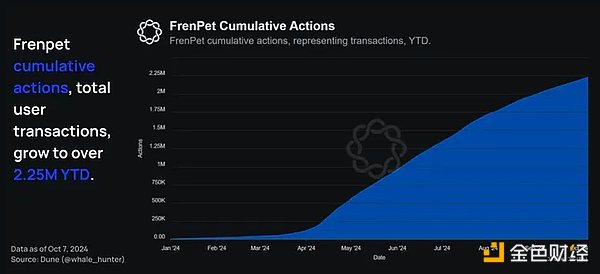
Base The gaming scene is just getting started, and as Base continues to attract more users to its network, there's a chance that fun little games like Frenpet will start to take off.
NFT/Digital Collectibles
NFT transaction volume across networks including Base has been on a downward trend for most of this year, but in August Hitting bottom (at least temporarily).
As of the end of the first quarter of 2024, we are seeing an upward trend in transaction volume. This excludes the outlier in late October, which returned to the mean the next day.
NFT transaction volume on Base corresponds to peak activity in different periods, and there is a lack of consistency within quarters. The most likely reason is that specific NFT initiatives have temporarily boosted NFT trading volumes.
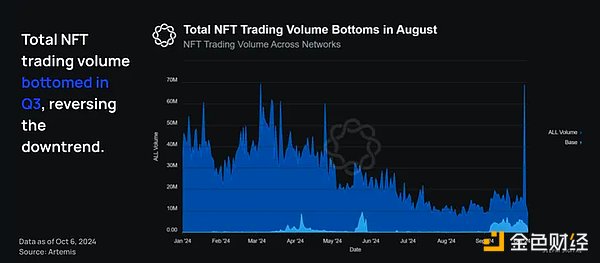
Interesting However, so far this year, the weekly NFT minting volume on Base has increased from a peak of 17.12 million in the first week of June to 832,000 at the end of October, an increase of 5 million. This indicator shows a counter trend of increased NFT activity.
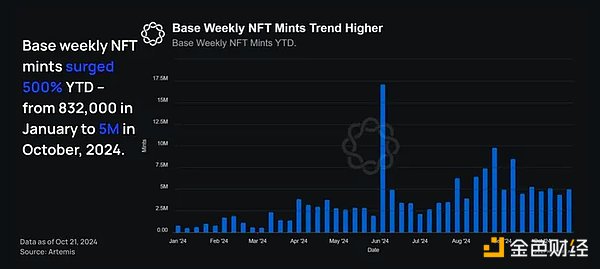 Year to Date To date, this number has grown by 500%, indicating that Base is becoming the center of NFTs for non-monetary use cases.
Year to Date To date, this number has grown by 500%, indicating that Base is becoming the center of NFTs for non-monetary use cases.
Based on NFT activity on Base and other networks, NFT behavior appears to be shifting away from trading/speculation towards non-monetary use cases for NFTs. This is illustrated by a 500% increase in weekly NFT minting volume on Base between January and October 2024, followed by a significant drop in NFT trading volume between March and October 2024.
Beyond art, the true value of NFTs, such as Bored Apes, is their ability to be tied to real-world utility. Examples of this real-world utility include NFTs representing membership in a coveted group or a deed to real estate.
Minting has been trending upward since Coinbase launched its Onchain Summer program, which encourages participants to mint NFTs—often at little or no cost (via gasless transactions). This shows that Onchain Summer has a lasting impact on user engagement, as users remain active after the program ends.
Decentralized Finance (DeFi) provides financial products and services at an institutional scale, but without intermediaries to absorb value. With DeFi, value can be redistributed to participants. Like most networks, DeFi remains dominant on Base and takes advantage of transaction fees below one cent. The following sections cover four different embedded areas: DEX/Derivatives, Money Markets, Telegram Bots, and Liquidity Staking/Yield Farming.
Trading platform
Base has become an important area for spot asset trading, and daily trading volume continues to grow. Year-to-date, Base DEX trading volume has grown 3,900% from $22 million in January to $880 million by the end of October 2024.
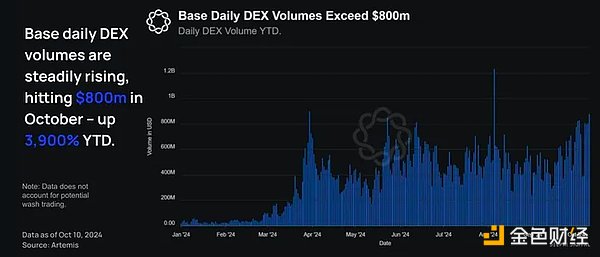
Combine these two Metrics, the Aerodrome is the clear winner. Aerodrome’s total TVL has exceeded $1 billion, accounting for approximately 40% of Base’s total TVL, and facilitates the highest on-chain volume pools among ETH, BTC, USDC, and EURC. The protocol is a fork of velodrome, a Curve-inspired automated market maker (AMM) that aims to serve as a liquidity center on Optimism.
Aerodrome plays the same role on Base and has been hugely successful so far - accounting for the majority (~50-60%) of the DeFi trading volume on Base.
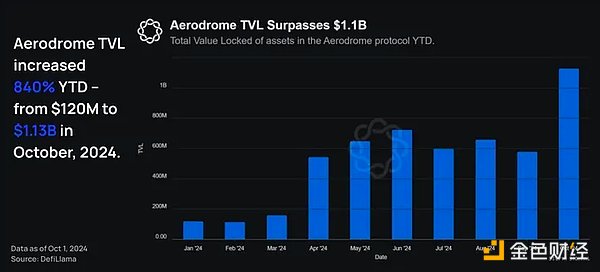 Aerodrome is particularly attractive for financial transactions. Users can redeem USDC and EURC within 1-5 seconds at a fee of 0.05%, 24/7 with no delays and virtually no slippage. By comparison, traditional financial transfers can take 1-5 business days and have fees ranging from 0.3% (Wise, on the low end, which charges 6 times as much as Aerodrome) to 3% (Wells Fargo, which charges 60 times as much as Aerodrome). Additionally, international transactions on Aerodrome are available 24/7 and take only 1-5 seconds, compared to 1-5 business days for traditional financial transactions.
Aerodrome is particularly attractive for financial transactions. Users can redeem USDC and EURC within 1-5 seconds at a fee of 0.05%, 24/7 with no delays and virtually no slippage. By comparison, traditional financial transfers can take 1-5 business days and have fees ranging from 0.3% (Wise, on the low end, which charges 6 times as much as Aerodrome) to 3% (Wells Fargo, which charges 60 times as much as Aerodrome). Additionally, international transactions on Aerodrome are available 24/7 and take only 1-5 seconds, compared to 1-5 business days for traditional financial transactions.
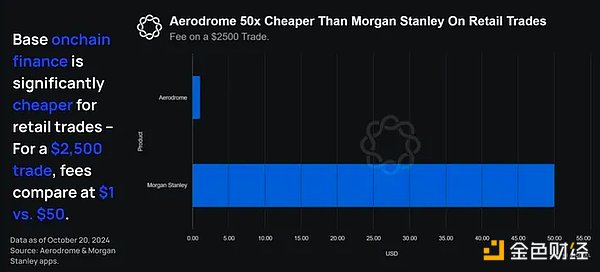 Users like familiar structures so that they can start from real benefits from the agreement. This is why in the early stages of most networks outside of Ethereum, Uniswap did not hold the majority of the market share, but rather the native AMM.
Users like familiar structures so that they can start from real benefits from the agreement. This is why in the early stages of most networks outside of Ethereum, Uniswap did not hold the majority of the market share, but rather the native AMM.
Most alternative network-native AMMs have traditionally had complex user incentives centered around staking tokens to earn emissions or protocol fees. Once this happens, the flywheel kicks into gear and native AMMs attract all the liquidity. Uniswap usually doesn’t become a market leader right away. This is reflected in several rollups: Base (Aerodrome), Optimism (Velodrome), and zkSync (Maverick).
What needs to be noted here is: as rollup matures, this flywheel will often break, and Uniswap liquidity on the network will continue to grow and seize market share. Aerodrome's incentive structure makes it the clear leader on Base in terms of TVL and transaction volume, however, this may change as the rollup ecosystem matures.
Currency Market
The three major currency markets account for most of Base’s market share: Morpho Blue (USD 220 million), Aave (USD 150 million) and Moonwell ($146 million). These numbers represent active deposits on the platform.
Morpho Blue is a trustless platform containing an immutable, independent lending market. MetaMorpho allows third parties to offer their own customized vaults on Morpho Blue. Morpho Blue automatically handles the maintenance of structural forces on market parameters to ensure the market remains solvent.
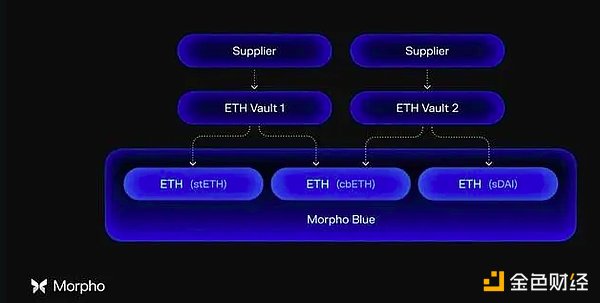
Isolated lending market Very powerful because they isolate the risk of each collateral asset. This means that Morpho Blue could technically add "riskier" collateral (e.g. less liquid and more volatile assets like uSUI) and increase its revenue without increasing the amount offered in the market. External risks with “stronger” collateral (e.g. ETH). The disadvantage of this is that the borrower cannot benefit from large deposits in other vaults.
Aave, on the other hand, is a traditional DeFi lending marketplace with all pools tied together, allowing users to submit any collateral selection and borrow any enabled asset. Due to its resiliency and long-term reputation, Aave is the “de facto” lending marketplace for most networks.
Moonwell offers users a combination of both. Moonwell is a fork of Aave that can take deposits using collateral from any acceptable asset. They also have core vaults built on top of Morpho for a more independent lending pool. The combined offering allows users to choose the infrastructure they want to use, managed by the Moonwell DAO.
Having three competitive lending markets on Base is a healthy sign of decentralization and competition and helps promote user innovation and choice. While many networks with Aave as the dominant currency market suffer from SPF (single point of failure), this won’t be the case with Base as funds are spread across multiple protocols.
This is optimal for long-term growth, although it requires more total liquidity to reduce the impact of fragmentation. More choice and competition are good for users, and the growth of Base DeFi allows every lending market to build enough liquidity to meet the needs of almost all users. The continued growth of the ecosystem will benefit all lending markets and reduce the impact of liquidity fragmentation, thereby benefiting users.
Telegram Bots
Driven by a dramatic increase in on-chain transactions and a simplified user experience, Telegram bots have gained momentum across most networks, leading to There has been a major shiftin retail investor behavior this year.
Telegram bots function to snipe and efficiently trade on-chain assets for users, giving it an advantage over users who trade manually using self-hosted wallets. Most bots charge about 1% on trades.
Using Telegram bots for on-chain asset transactions has significant user experience advantages. As a result, Telegram bot adoption continues to grow, with daily revenue consistently exceeding $1 million.
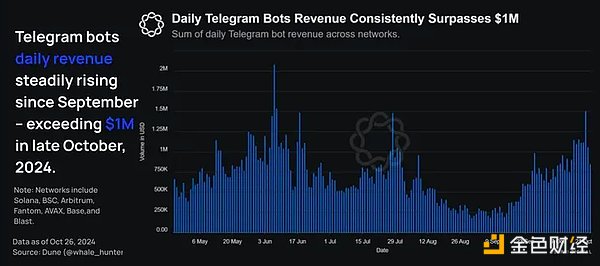 Contrary to other networks, the number of Telegram bots on Base Not high, indicating a lack of adoption.
Contrary to other networks, the number of Telegram bots on Base Not high, indicating a lack of adoption.
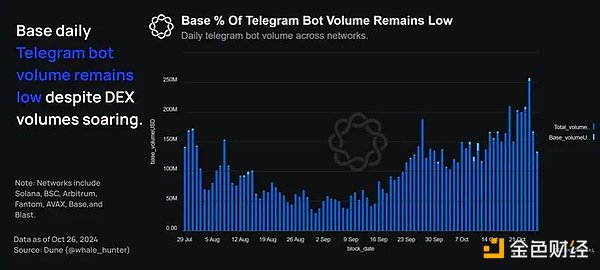 The lower number of Telegram bots plus the continuous increase in Base The rising number of DEXs seems to indicate that Base has attracted a large number of actual users, and there is also migration activity from other networks to Base.
The lower number of Telegram bots plus the continuous increase in Base The rising number of DEXs seems to indicate that Base has attracted a large number of actual users, and there is also migration activity from other networks to Base.
Yield Activities
Decentralized yield farming of cryptocurrencies is very popular. Since almost all cryptocurrencies are financial in nature, a tool to maximize returns without centralized risk is very attractive to many users, driving adoption.
However, Base is not a chain built for profit, but to create an on-chain global economy. Only a small portion of the assets on Base are actively leveraged income activity, as most capital from institutions is risk-averse and prefers to hold these assets, or in some cases, from licensed participants Borrow there.
Base’s top yield platform (provided by TVL) is Extra Finance, which offers a range of leveraged yield products.
They have amassed over $150 million in TVL (while significant, it is a small fraction of the $8 billion in assets on Base), and their user trading volume is close to May 2024 highs Points - Daily trading volume regularly exceeds 2,000 transactions.
 Extra's leverage return design is a streamlined But smart design can maximize the benefits for everyone involved. The process follows the following structure:
Extra's leverage return design is a streamlined But smart design can maximize the benefits for everyone involved. The process follows the following structure:
Provide collateral -> Borrow different assets from the lending pool -> Automatically convert assets into equal proportions -> Provide liquidity -> Compound rewards
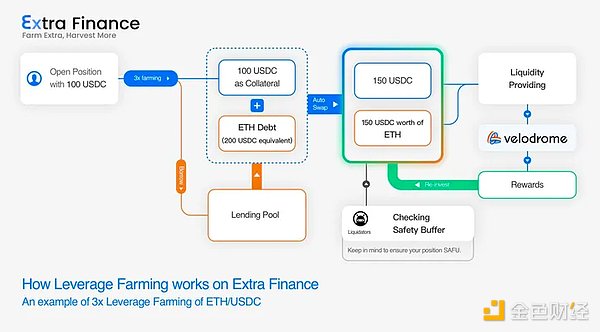
Users who do not want to take advantage of the proceeds can lend their assets to mining pools to earn interest rates, similar to any other lending market.
Base can prioritize work on decentralized stacks (such as failure proofing) and help the wider Ethereum ecosystem, as there is ample developer activity on Base.
We are seeing this in practice today - weekly contract volumes are significantly higher than at the beginning of the year, increasing from 5,400 in early January to 72,300 in October, a 1,200% increase.
Note: The number of contracts deployed per week refers to the number of unique on-chain contracts deployed on Base every week.
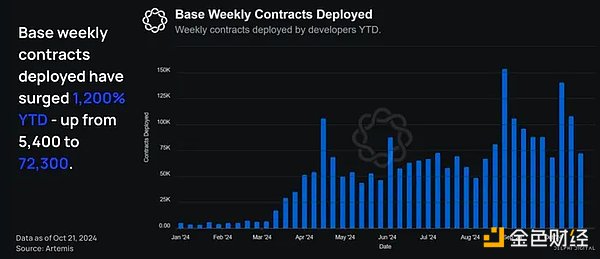 Weekly Base contracts deployed by unique addresses so far this year
Weekly Base contracts deployed by unique addresses so far this year
In addition, Base also found that by The number of contracts deployed to unique addresses is increasing rapidly. Since January, the number of contracts deployed via unique addresses per week has increased from 3,700 to 32,500, a 778% increase.
Note: The number of contracts deployed by unique addresses each week refers to the number of on-chain contracts deployed on Base by developers who have not deployed contracts that week.
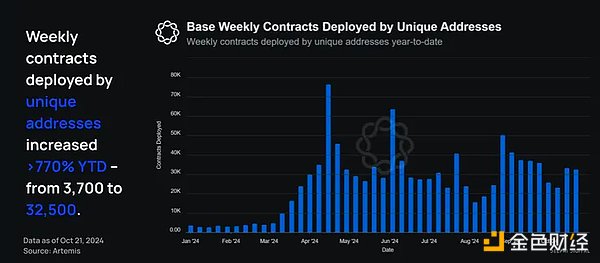
Although this metric has declined slightly since April, the overall trend is still increasing, which is a strong indication that the Base on-chain application developer ecosystem is thriving. Additionally, it shows that the team’s development efforts to make Base a developer-friendly chain are succeeding.
For the section involving non-public information, we interviewed recruiters from different headhunting firms.
The number of companies hiring engineers with smart contract expertise has increased so far this year
According to our According to sources, in the first two quarters of 2024, the number of companies recruiting engineers to work on on-chain development has increased dramatically. After EthCC, this growth slowed somewhat as the traditional “summer slowdown” occurred and prices fell. Yet even during this period, there was a clear uptick in hiring relative to other periods of declining prices.
Our sources noticed an interesting trend: during bear markets, there is a greater focus on infrastructure, leading to more developers working on infrastructure-related issues. Conversely, in a bull market, people actively optimize for mass adoption, which results in more consumer apps being funded and therefore more developers working on developing consumer apps.
More job opportunities for crypto-savvy applicants
According to our sources, industry demand for crypto-native job seekers demand is increasing. Crypto-native talent understands how blockchain projects market to users because the candidate was/still is a user—a clear advantage over candidates who don’t understand crypto. One source added that crypto-native employees who are familiar with niche marketing structures that appeal to the crypto community are key to a successful marketing strategy.
Interestingly, demand for networking events for crypto-native talent surged in Q1 and Q2, coinciding with protocols launching their products and tokens. However, our sources note that companies in the cryptocurrency industry still place a high value on prestige. Even for crypto-native candidates, factors like attending an Ivy League school are often highly valued in the hiring process.
According to our sources, the demand for cryptocurrency natives and candidates with prestigious backgrounds has resulted in many positions within the industry being restricted to a limited number of applicants.
On what builders/protocols/founders think about the talent pool
Our sources indicate that before the collapse of FTX, Luna and Three Arrows Capital , the industry’s talent pool is broader and more diverse, with candidates coming from a variety of fields outside of computer science. Clearly, the impact of these events on the crypto industry extends far beyond a decline in market valuations. General reputation issues remain, reducing the number of applicants willing to work in an industry they view as unstable.
This bias against cryptocurrencies is also reflected in declining interest among students to join university blockchain clubs, according to one source. Prior to the aforementioned crash, there was a significant increase in demand for club memberships. Given the current competitive landscape for computer science and engineering internships, waning interest in an industry where opportunities are abundant is particularly concerning.
That said, the crypto industry will benefit from a stronger appeal to young builders for on-chain development — targeting interns and recent graduates.
Talent demand is strong, talent is in short supply
Despite poor market conditions, recruiters are seeing continued demand for engineering talent. Venture capital-backed projects compete fiercely for limited resources of technical engineers.
As a result, there is a clear shortage of crypto developers as demand continues to outstrip available talent. Interestingly, three sources added that many traditional developers are reluctant to pursue positions in crypto because they view the industry as unstable.
Three results from a recent Coinbase survey of on-chain and mainstream developers corroborate this claim, highlighting a lack of confidence in the ability to onboard new developers.
Half (49%) of mainstream developers believe that "encryption and blockchain are important areas of innovation in the future."
78% of on-chain developers agree that “it used to be difficult to get new users started using cryptocurrencies and blockchain applications.”
73% of on-chain developers stated that “a lack of clarity in crypto regulations makes it more difficult to innovate in the space.”
Coinbase is actively seeking clearer regulation globally on behalf of the industry. Progress in this area may help remove barriers to innovation for developers and promote the overall development of the on-chain economy.
In 2024, the on-chain economy will undoubtedly usher in explosive growth. Much of this growth has been driven by activities other than financial speculation and trading. Stablecoins have found product-market fit and are driving a more global digital economy. L2 reduces on-chain costs, making on-chain construction easier, faster, and cheaper.
In just over a year, Base has solidified its position as the L2 leader. By building an ecosystem that attracts developers with minimal transaction fees, Base creates an environment that not only attracts developers and users, but also has high retention rates.
DeFi remains the core of on-chain economic activity. DeFi provides financial products and services at an institutional scale, but without intermediaries who absorb value. Instead, this value can be redistributed to participants.
At the same time, new use cases and applications are becoming an important part of the on-chain economy. Facilitating diverse on-chain application development and creating infrastructure to support various industries (such as gaming and SocialFi) means that on-chain experiences are constantly expanding, which is a major driver of the growing global on-chain economy.
Lower fees, more use cases, easier-to-use technology and innovative products have all contributed to the booming development of the on-chain economy.
The FAA has approved Archer Aviation to launch an aerial car rental service in New York City ahead of the 2028 Olympics
 Cheng Yuan
Cheng YuanAirdrop, how to design a satisfactory airdrop Golden Finance, reveals the important details that are easily overlooked in the design and execution of airdrops
 JinseFinance
JinseFinanceOn May 15, 2024, Sonne Finance was attacked on the Optimism chain, resulting in losses of up to $20 million.
 JinseFinance
JinseFinanceThe current cryptocurrency bull market offers notable opportunities in altcoins and airdrops, with a variety of platforms providing potential for significant returns.
 Kikyo
KikyoCapital A Bhd, the parent company of AirAsia, led by CEO Tony Fernandes, is in the process of securing over $1 billion in financing through a combination of debt and equity. This strategic move is aimed at reshaping the company's future and expanding its financial horizons.
 Joy
JoyFraudsters sentenced in the AirBit Club Ponzi scheme case, revealing a tale of deception and justice.
 Hui Xin
Hui XinWallet manufacturers debated the best ways to store bitcoin private keys safely at the BalticHoneybadger conference in Riga.
 Coindesk
CoindeskOne interaction, double airdrop protocol list
 链向资讯
链向资讯“Why should Optimism Collective continue rewarding these kinds of mercenary actors who will dump their tokens on first sight? Why should any future airdrops reward these addresses?” an OP governance member argued.
 Cointelegraph
Cointelegraph“Wow, what a day. OP Drop #1 had a turbulent launch which we finally stabilized after more than five hours of non-stop work,” Optimism stated.
 Cointelegraph
Cointelegraph